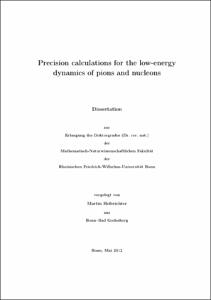Precision calculations for the low-energy dynamics of pions and nucleons

Precision calculations for the low-energy dynamics of pions and nucleons

| dc.contributor.advisor | Meißner, Ulf-G. | |
| dc.contributor.author | Hoferichter, Martin | |
| dc.date.accessioned | 2020-04-17T23:49:32Z | |
| dc.date.available | 2020-04-17T23:49:32Z | |
| dc.date.issued | 18.07.2012 | |
| dc.identifier.uri | https://hdl.handle.net/20.500.11811/5346 | |
| dc.description.abstract | QCD is strongly coupled at long distances and therefore non-perturbative methods are required to understand its low-energy properties, e.g. to answer such basic questions as of the origin of the nucleon mass. In this thesis we study the interplay of effective field theories and dispersion relations in the description of strong and electromagnetic interactions of pions and nucleons. In the first part, we use chiral perturbation theory to calculate the π--deuteron scattering length to a few-percent accuracy including isospin-violating corrections. We apply the result to perform a combined analysis of data on pionic deuterium and pionic hydrogen atoms that leads to a precision determination of the isoscalar and isovector pion-nucleon scattering lengths, and discuss the consequences for the πN coupling constant and the pion-nucleon σ term. In the second part, we derive a system of Roy-Steiner equations for pion Compton scattering that respects analyticity, unitarity, gauge invariance, and crossing symmetry, and thus maintains all symmetries of the underlying quantum field theory. To suppress the dependence on the high-energy input, we also consider subtracted versions of the equations, identifying the subtraction constants with pion polarizabilities. Based on the assumption of Mandelstam analyticity, we determine the kinematic range in which the equations are valid. We solve for the γγ→ππ partial waves using a Muskhelishvili-Omnès representation and derive a correlation between the two-photon coupling of the σ resonance and the isospin-zero pion polarizabilities, which, in combination with chiral perturbation theory, provides new rigorous constraints on the σ→γγ coupling. In the final part, we construct a similar system of Roy-Steiner equations for pion-nucleon scattering. We study the solution of the N̅N→ππ partial waves by Muskhelishvili-Omnès techniques, taking into account coupled-channel effects in the case of the S-wave, and apply the results to a two-channel dispersive calculation of the scalar form factor of the nucleon. We develop a solution strategy for the pion-nucleon s-channel partial waves and determine the corrections needed for the extraction of the pion-nucleon σ term from the extrapolation of the πN amplitude to the Cheng-Dashen point by means of a low-energy theorem. | en |
| dc.language.iso | eng | |
| dc.rights | In Copyright | |
| dc.rights.uri | http://rightsstatements.org/vocab/InC/1.0/ | |
| dc.subject | QCD | |
| dc.subject | Dispersionsrelationen | |
| dc.subject | Chirale Störungstheorie | |
| dc.subject | Roy-Steiner-Gleichungen | |
| dc.subject.ddc | 530 Physik | |
| dc.title | Precision calculations for the low-energy dynamics of pions and nucleons | |
| dc.type | Dissertation oder Habilitation | |
| dc.publisher.name | Universitäts- und Landesbibliothek Bonn | |
| dc.publisher.location | Bonn | |
| dc.rights.accessRights | openAccess | |
| dc.identifier.urn | https://nbn-resolving.org/urn:nbn:de:hbz:5n-29234 | |
| ulbbn.pubtype | Erstveröffentlichung | |
| ulbbnediss.affiliation.name | Rheinische Friedrich-Wilhelms-Universität Bonn | |
| ulbbnediss.affiliation.location | Bonn | |
| ulbbnediss.thesis.level | Dissertation | |
| ulbbnediss.dissID | 2923 | |
| ulbbnediss.date.accepted | 12.07.2012 | |
| ulbbnediss.fakultaet | Mathematisch-Naturwissenschaftliche Fakultät | |
| dc.contributor.coReferee | Hammer, Hans-Werner |
Dateien zu dieser Ressource
Das Dokument erscheint in:
-
E-Dissertationen (4373)




